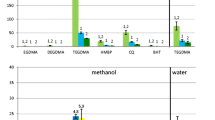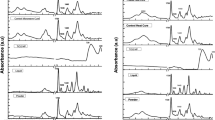Abstract
Objectives
To analyse the residual monomer (MMA) elution of polymethyl methacrylate (PMMA) in distilled water after diverse fabrication methods and aging procedures.
Materials and methods
PMMA specimens (N = 192, PalaXpress; Kulzer, Hanau, Germany) were manufactured (pouring, n = 96/injection, n = 96) and polymerized in water (55°C) without pressure (n = 48) and with 2 bar pressure (n = 48). Specimens were grinded (n = 24) or polished (n = 24) and aged for 12 h in distilled water/37°C (n = 12) or at air/20°C (n = 12) and stored afterwards in distilled water at 37°C. MMA elution was evaluated after 1, 2, 3, 4, 5, 6, 7, 10, 15 days (UV/Vis spectrophotometry). Data were analysed with Kolmogorov-Smirnov, Mann-Whitney-U and Cohen-d test using SPSS (α < 0.5).
Results
The pouring procedure resulted in significantly higher MMA elution than the injection procedure up to 5 days. Polymerization with a pressure of 2 bar reduced the MMA elution significantly for poured specimens. Polishing reduced the MMA elution in comparison to grinding.
Conclusions
The fabrication procedure (pouring/injection) showed the strongest correlation to the MMA elution (r = 0.500), followed by polishing (r = 0.243), the pressure during polymerization (r = 0.109) and the storage medium (r = 0.053).
Clinical relevance
Higher MMA elution may increase the risk of chemical irritations, allergic reactions and hypersensitivities of the oral mucosa. Technicians and dentists should be aware about the elution differences dependent on the fabrication procedure.




Similar content being viewed by others
References
Ica RB, Ozturk F, Ates B, Malkoc MA, Kelestemur U (2014) Level of residual monomer released from orthodontic acrylic materials. Angle Orthod 84(5):862–867. https://doi.org/10.2319/060713-435.1
Bayraktar G, Guvener B, Bural C, Uresin Y (2006) Influence of polymerization method, curing process, and length of time of storage in water on the residual methyl methacrylate content in dental acrylic resins. J Biomed Mater Res B Appl Biomater 76(2):340–345. https://doi.org/10.1002/jbm.b.30377
Ayman AD (2017) The residual monomer content and mechanical properties of CAD\CAM resins used in the fabrication of complete dentures as compared to heat cured resins. Electron Physician 9(7):4766–4772. https://doi.org/10.19082/4766
Gautam R, Singh RD, Sharma VP, Siddhartha R, Chand P, Kumar R (2012) Biocompatibility of polymethylmethacrylate resins used in dentistry. J Biomed Mater Res B Appl Biomater 100(5):1444–1450. https://doi.org/10.1002/jbm.b.32673
Urban VM, Machado AL, Oliveira RV, Vergani CE, Pavarina AC, Cass QB (2007) Residual monomer of reline acrylic resins: effect of water-bath and microwave post-polymerization treatments. Dent Mater 23(3):363–368. https://doi.org/10.1016/j.dental.2006.01.021
Urban VM, Machado AL, Vergani CE, Giampaolo ET, Pavarina AC, de Almeida FG, Cass QB (2009) Effect of water-bath post-polymerization on the mechanical properties, degree of conversion, and leaching of residual compounds of hard chairside reline resins. Dent Mater 25(5):662–671. https://doi.org/10.1016/j.dental.2008.10.017
Bettencourt AF, Neves CB, de Almeida MS, Pinheiro LM, Oliveira SA, Lopes LP, Castro MF (2010) Biodegradation of acrylic based resins: a review. Dent Mater 26(5):e171–e180. https://doi.org/10.1016/j.dental.2010.01.006
Goodacre CJ, Garbacea A, Naylor WP, Daher T, Marchack CB, Lowry J (2012) CAD/CAM fabricated complete dentures: concepts and clinical methods of obtaining required morphological data. J Prosthet Dent 107(1):34–46. https://doi.org/10.1016/S0022-3913(12)60015-8
Ayaz EA, Durkan R, Koroglu A, Bagis B (2014) Comparative effect of different polymerization techniques on residual monomer and hardness properties of PMMA-based denture resins. J Appl Biomater Funct Mater 12(3):228–233. https://doi.org/10.5301/jabfm.5000199
Vallittu PK, Miettinen V, Alakuijala P (1995) Residual monomer content and its release into water from denture base materials. Dent Mater 11(5):338–342. https://doi.org/10.1016/0109-5641(95)80031-X
Shim JS, Watts DC (1999) Residual monomer concentrations in denture-base acrylic resin after an additional, soft-liner, heat-cure cycle. Dent Mater 15(4):296–300. https://doi.org/10.1016/S0109-5641(99)00048-2
Zissis A, Yannikakis S, Polyzois G, Harrison A (2008) A long term study on residual monomer release from denture materials. Eur J Prosthodont Restor Dent 16(2):81–84
Nik TH, Shahroudi AS, Eraghihzadeh Z, Aghajani F (2014) Comparison of residual monomer loss from cold-cure orthodontic acrylic resins processed by different polymerization techniques. J Orthod 41(1):30–37. https://doi.org/10.1179/1465313313y.0000000078
Steinmassl PA, Wiedemair V, Huck C, Klaunzer F, Steinmassl O, Grunert I, Dumfahrt H (2017) Do CAD/CAM dentures really release less monomer than conventional dentures? Clin Oral Investig 21(5):1697–1705. https://doi.org/10.1007/s00784-016-1961-6
DIN EN ISO 20795-1:2013-06: Dentistry - base polymers - Part 1: denture base polymers (ISO 20795-1:2013); German version EN ISO 20795-1:2013. doi:
Urban VM, Cass QB, Oliveira RV, Giampaolo ET, Machado AL (2006) Development and application of methods for determination of residual monomer in dental acrylic resins using high performance liquid chromatography. Biomed Chromatogr 20(4):369–376. https://doi.org/10.1002/bmc.575
Denis AB, Diagone CA, Plepis AM, Viana RB (2015) The effect of the polymerization initiator and light source on the elution of residual Bis-GMA and TEGDMA monomers: a study using liquid chromatography with UV detection. Spectrochim Acta A Mol Biomol Spectrosc 151:908–915. https://doi.org/10.1016/j.saa.2015.07.040
Tuna EB, Rohlig BG, Sancakli E, Evlioglu G, Gencay K (2013) Influence of acrylic resin polymerization methods on residual monomer release. J Contemp Dent Pract 14(2):259–264
Lamb DJ, Ellis B, Priestley D (1982) Loss into water of residual monomer from autopolymerizing dental acrylic resin. Biomaterials 3(3):155–159
Stafford GD, Brooks SC (1985) The loss of residual monomer from acrylic orthodontic resins. Dent Mater 1(4):135–138
Jorge JH, Giampaolo ET, Machado AL, Vergani CE (2003) Cytotoxicity of denture base acrylic resins: a literature review. J Prosthet Dent 90(2):190–193. https://doi.org/10.1016/S0022391303003494
Vallittu PK, Ruyter IE, Buykuilmaz S (1998) Effect of polymerization temperature and time on the residual monomer content of denture base polymers. Eur J Oral Sci 106(1):588–593
Lamb DJ, Ellis B, Priestley D (1983) The effects of process variables on levels of residual monomer in autopolymerizing dental acrylic resin. J Dent 11(1):80–88
Kedjarune U, Charoenworaluk N, Koontongkaew S (1999) Release of methyl methacrylate from heat-cured and autopolymerized resins: cytotoxicity testing related to residual monomer. Aust Dent J 44(1):25–30
Gauthier MA, Stangel I, Ellis TH, Zhu XX (2005) Oxygen inhibition in dental resins. J Dent Res 84(8):725–729. https://doi.org/10.1177/154405910508400808
Baker S, Brooks SC, Walker DM (1988) The release of residual monomeric methyl methacrylate from acrylic appliances in the human mouth: an assay for monomer in saliva. J Dent Res 67(10):1295–1299. https://doi.org/10.1177/00220345880670101001
Blanchet LJ, Bowman DC, McReynolds HD (1982) Effects of methyl methacrylate monomer vapors on respiration and circulation in unanesthetized rats. J Prosthet Dent 48(3):344–348
Oysaed H, Ruyter IE, Sjovik Kleven IJ (1988) Release of formaldehyde from dental composites. J Dent Res 67(10):1289–1294. https://doi.org/10.1177/00220345880670100901
Vallittu PK (1996) The effect of surface treatment of denture acrylic resin on the residual monomer content and its release into water. Acta Odontol Scand 54(3):188–192
Goiato, M.C., E. Freitas, D. dos Santos, R. de Medeiros, and M. Sonego (2015) Acrylic Resin Cytotoxicity for Denture Base--Literature Review. Adv Clin Exp Med 24(4):679-686. doi: 10.17219/acem/33009
Author information
Authors and Affiliations
Corresponding author
Ethics declarations
Conflict of interest
The authors declare that they have no conflict of interest.
Ethical approval
This article does not contain any studies with human participants or animals performed by any of the authors.
Informed consent
For this type of study, formal consent is not required.
Additional information
Publisher’s note
Springer Nature remains neutral with regard to jurisdictional claims in published maps and institutional affiliations.
Rights and permissions
About this article
Cite this article
Keul, C., Seidl, J., Güth, JF. et al. Impact of fabrication procedures on residual monomer elution of conventional polymethyl methacrylate (PMMA)—a measurement approach by UV/Vis spectrophotometry. Clin Oral Invest 24, 4519–4530 (2020). https://doi.org/10.1007/s00784-020-03317-1
Received:
Accepted:
Published:
Issue Date:
DOI: https://doi.org/10.1007/s00784-020-03317-1




